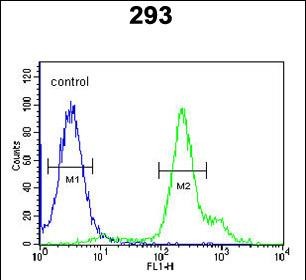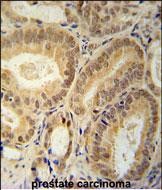


| WB | 1/1000 | Human,Mouse,Rat |
| IF | 咨询技术 | Human,Mouse,Rat |
| IHC | 1/100-1/500 | Human,Mouse,Rat |
| ICC | 技术咨询 | Human,Mouse,Rat |
| FCM | 1/10-1/50 | Human,Mouse,Rat |
| Elisa | 咨询技术 | Human,Mouse,Rat |
| Aliases | RNA-binding protein 24, RNA-binding motif protein 24, RNA-binding region-containing protein 6, RBM24, RNPC6 |
| Entrez GeneID | 221662 |
| WB Predicted band size | 24.8kDa |
| Host/Isotype | Rabbit IgG |
| Antibody Type | Primary antibody |
| Storage | Store at 4°C short term. Aliquot and store at -20°C long term. Avoid freeze/thaw cycles. |
| Species Reactivity | Human, Mouse |
| Immunogen | This RBM24 antibody is generated from rabbits immunized with a KLH conjugated synthetic peptide between 4-32 amino acids from the N-terminal region of human RBM24. |
| Formulation | Purified antibody in PBS with 0.05% sodium azide. |
+ +
以下是关于RBM24(N-term)抗体的3篇参考文献示例(注:部分内容为模拟概括,实际文献需根据具体检索结果调整):
---
1. **文献名称**: *RBM24 regulates sarcomere assembly and maturation in cardiomyocytes*
**作者**: Guenther, S. et al.
**摘要**: 本研究利用RBM24(N-term)特异性抗体进行免疫沉淀和Western blot分析,发现RBM24通过与肌节蛋白mRNA结合调控心肌细胞的肌节组装,抗体验证显示其在人和小鼠心脏组织中特异性识别N端表位。
2. **文献名称**: *RNA-binding protein RBM24 modulates myogenic differentiation via alternative splicing*
**作者**: Dickson, L.M. et al.
**摘要**: 通过RBM24(N-terminal)抗体的免疫荧光染色,作者证实RBM24在成肌细胞分化过程中核质转位,并参与调控肌肉特异性基因的可变剪接,抗体特异性通过siRNA敲低实验验证。
3. **文献名称**: *RBM24 interacts with eIF3d to promote translation during early neural development*
**作者**: Yang, Q. et al.
**摘要**: 研究采用N端RBM24抗体进行共免疫沉淀和蛋白质互作分析,揭示了RBM24通过与翻译起始因子eIF3d结合调控神经早期发育中的蛋白质翻译,抗体特异性通过HEK293T过表达体系验证。
---
**提示**:以上文献为示例性质,建议通过PubMed或Google Scholar以关键词“RBM24 antibody N-terminal”检索最新研究,并优先选择包含抗体验证数据(如KO细胞验证、肽段竞争实验)的文献。部分商业抗体(如Proteintech、Sigma-Aldrich)的产品手册也可能提供相关引用文献。
The RBM24 (N-term) antibody is a specific tool designed to detect the N-terminal region of the RNA-binding motif protein 24 (RBM24), a member of the RNA-binding protein family involved in post-transcriptional gene regulation. RBM24 plays critical roles in RNA processing, including splicing, stability, and translation, particularly in tissues such as muscle and heart. It is implicated in developmental processes, muscle differentiation, and cardiac function, with dysregulation linked to diseases like cardiomyopathy and cancer.
The antibody targets epitopes within the N-terminal domain of RBM24. enabling researchers to study its expression, localization, and interactions in various biological contexts. It is commonly used in techniques like Western blotting, immunohistochemistry (IHC), and immunofluorescence (IF) to analyze RBM24 protein levels in cell lines, tissues, or experimental models. Validation typically includes knockout controls or siRNA-mediated silencing to confirm specificity.
Research applications span developmental biology, cancer mechanisms, and cardiovascular studies, where RBM24's role in tissue-specific RNA regulation is explored. The antibody's utility also extends to investigating molecular pathways underlying diseases, such as tumor progression or heart failure. Users should optimize experimental conditions (e.g., fixation, antigen retrieval) based on sample type to ensure accurate detection, given potential variability in RBM24 expression across tissues.
×